Crystallographic Analysis of Plate and Lath Martensite in Fe-Ni Alloys
Abstract
:1. Introduction
2. Materials and Methods
2.1. Materials Processing and Orientation Imaging
2.2. Martensite Crystallography and Evaluation of EBSD Data
3. Results
3.1. Martensite Microstructures
3.2. Statisticaal Analysis of the OR
4. Discussion
5. Conclusions
Author Contributions
Funding
Data Availability Statement
Conflicts of Interest
References
- Osmond, F. Méthode générale pour l’analyse micrographique des aciers au carbone. Bulletin de la Société d’Encouragement pour l’indutrie Nationale 1895, 10, 476–518. [Google Scholar]
- Martens, A. Über das Kleingefüge des schmiedbaren Eisens, besonders des Stahles. Stahl Eisen 1887, 7, 235–242. [Google Scholar]
- Bain, E.C.; Dunkirk, N.Y. The nature of martensite. Trans. AIME 1924, 70, 25–46. [Google Scholar]
- Kurdjumow, G.; Sachs, G. Über den Mechanismus der Stahlhärtung, Z. Physik 1930, 64, 325–343. [Google Scholar] [CrossRef]
- Nishiyama, Z. X-ray investigation of the mechanism of the transformation from face-centred cubic lattice to body-centred cubic, Science Reports of the Tohoku Imperial University, Series 1: Mathematics. Phys. Chem. 1934, 23, 637–664. [Google Scholar]
- Wassermann, G. Über den Mechanismus der α/γ-Umwandlung des Eisens; Mitteilungen aus dem Kaiser-Wilhelm-Institut für Eisenforschung zu; Verlag Stahleisen: Düsseldorf, Germany, 1935. [Google Scholar]
- Wechsler, M.S.; Liebermann, D.S.; Read, T.A. On the theory of the formation of martensite. Trans. AIME 1953, 197, 1503–1515. [Google Scholar]
- Knapp, H.; Dehlinger, U. Mechanik und Kinetik der diffusionslosen Martensitbildung. Acta Metall. 1956, 4, 289–297. [Google Scholar] [CrossRef]
- Wayman, C.M. Introduction to the crystallography of martensitic transformations. Macmillan Siries Mater. Sci. 1964. [Google Scholar]
- Nishiyama, Z. Martensitic Transformation; Academic Press: London, UK, 1978. [Google Scholar]
- Olson, G.B.; Owen, W.S. Martensite—A Tribute to Morris Cohen. ASM Int. 1992. [Google Scholar]
- Wayman, C.M.; Bhadeshia, H.K.D.H. Nondiffusive phase transformations. In Physical Metallurgy, 4th ed.; Cahn, R.W., Haasen, P., Eds.; North-Holland: Amsterdam, The Netherlands, 1996; Volume 2, pp. 1507–1554. [Google Scholar]
- Christian, J.E. The Theory of Transformations in Metals and Alloys; Parts 1 and 2; Pergamon: Amsterdam, The Netherlands, 2002. [Google Scholar]
- Kraus, G.; Marder, A.R. The morphology of martensite in iron alloys. Met. Trans. 1971, 2, 2343–2357. [Google Scholar] [CrossRef]
- Pereloma, E.; Edmonds, D.V. Phase Transformations in Steels: Diffusionless Transformations; Woodhead Publishing: Cambridge, UK, 2012. [Google Scholar]
- Kelly, P.M.; Nutting, J. The morphology of martensite. J. Iron Steel Inst. 1961, 197, 199–211. [Google Scholar]
- Speich, G.R.; Swann, P.R. Yield strength and transformation substructure of quenched iron nickel alloys. J. Iron Steel Inst. 1965, 203, 480–485. [Google Scholar]
- Owen, W.S.; Wilson, E.A.; Bell, T. High Strength Materials; John Wiley and Sons: New York, NY, USA, 1965; pp. 167–208. [Google Scholar]
- Morito, S.; Huang, X.; Furuhara, T.; Maki, T.; Hansen, N. The morphology and crystallography of lath martensite in alloyed steels. Acta Mater. 2006, 54, 5323–5331. [Google Scholar] [CrossRef]
- Patterson, R.L.; Wayman, C.M. Crystallography and growth of partially-twinned martensite plates in Fe-Ni alloys. Acta Metall. 1966, 14, 347–369. [Google Scholar] [CrossRef]
- Krauss, G. Martensite in steel: Strength and structure. Mat. Sci. Eng. A 1990, 273, 40–57. [Google Scholar] [CrossRef]
- Kitahara, H.; Ueji, R.; Ueda, M.; Tsuji, N. Minamino, Crystallographic analysis of plate martensite in Fe-28.5 at.% Ni by FE-SEM/EBSD. Mater. Charact. 2005, 54, 378–386. [Google Scholar] [CrossRef]
- Kitahara, H.; Ueda, M.; Tsuji, N. Minamino, Variant selection of plate martensite in Fe-28.5 at.% Ni alloy. Mater. Sci. Forum 2006, 512, 117–121. [Google Scholar] [CrossRef]
- Hansen, M.; Anderko, K. Constitution of Binary Alloys; McGraw-Hill Book Company: New York, NY, USA, 1958. [Google Scholar]
- Swartzendruber, L.J.; Itkin, V.P.; Alcock, C.B. The iron-nickel system. J. Phase Equilibria 1991, 12, 288–312. [Google Scholar] [CrossRef]
- Schwartz, A.J.; Kumar, M.; Adams, B.L. Electron. Backscatter Diffraction in Materials Science; Kluwer Academic Publishers: New York, NY, USA, 2000. [Google Scholar]
- Randle, V.; Engler, O. Introduction to Texture Analysis: Macrotexture, Microtexture, and Orientation Mapping, 2nd ed.; CRC Press: London, UK, 2009. [Google Scholar]
- De Graef, M.; McHenry, M. Structure of Materials–An Introduction to Crystallography, Diffraction and Symmetry, 2nd ed.; Cambridge University Press: Cambridge, UK, 2012. [Google Scholar]
- Nishikawa, S.; Kikuchi, S. The diffraction of cathode rays by calcite. Proc. Imp. Acad. Jpn. 1928, 4, 475–477. [Google Scholar] [CrossRef] [Green Version]
- Von Heimendahl, M.; Bell, W.; Thomas, G. Applications of Kikuchi Line Analyses in Electron Microscopy. J. Appl. Phys. 1964, 35, 3614–3616. [Google Scholar] [CrossRef]
- Boersch, H.; Zeitschrift, P. About bands in electron diffraction. Phys. Z. 1937, 38, 1000–1004. [Google Scholar]
- Reimer, L. Scanning Electron Microscopy—Physics of Image Formation; Springer: Berlin, Germany, 1985. [Google Scholar]
- Dingley, D.J.; Randle, V. Microtexture determination by electron back-scatter detection. J. Mater. Sci. 1992, 27, 4545–4566. [Google Scholar] [CrossRef]
- Adams, B.L.; Wright, S.I.; Kunze, K. Orientation imaging–the emergence of a new microscopy. Metall. Trans. A 1993, 24, 819–831. [Google Scholar] [CrossRef]
- Gourgues, A.-F.; Flower, H.M.; Lindley, T.C. Electron back scattering diffraction study of acicular ferrite, bainite and martensite steel microstructures. Mater. Sci. Tech. 2000, 16, 26–40. [Google Scholar] [CrossRef]
- Morito, S.; Tanaka, H.; Konishi, R.; Furuhara, T.; Maki, T. The morphology and crystallography of lath martensite in Fe-C alloys. Acta Mater. 2003, 51, 1789–1799. [Google Scholar] [CrossRef]
- Kitahara, H.; Ueji, R.; Tsuji, N.; Minamino, Y. Crystallographic features of lath martensite in low carbon steel. Acta Mater. 2006, 54, 1279–1288. [Google Scholar] [CrossRef]
- Cayron, C.; Artaud, B.; Briottet, L. Reconstruction of parent grains from EBSD data. Mater. Charact. 2006, 57, 386–401. [Google Scholar] [CrossRef]
- Miyamoto, G.; Iwata, N.; Takayama, N.; Furuhara, T. Mapping the parent austenite orientation reconstructed from the orientation of martensite by EBSD. Acta Mater. 2010, 58, 6393–6403. [Google Scholar] [CrossRef]
- Miyamoto, G.; Takayama, N.; Furuhara, T. Accurate measurement of the orientation relationship of lath martensite and bainite by electron backscatter diffraction analysis. Scr. Mater. 2009, 60, 1113–1116. [Google Scholar] [CrossRef]
- Pham, A.H.; Ohba, T.; Morito, S.; Hayashi, T. Effect of chemical composition on average γ/α’ orientation relationship in carbon and low alloy steels. Mater. Today Proc. 2015, 2S, 663–666. [Google Scholar] [CrossRef]
- Zilnyk, K.D.; Junior, D.R.A.; Sandim, H.R.Z.; Rios, P.R.; Raabe, D. Misorientation distribution between martensite and austenite in Fe-31 wt% Ni-0.01 wt% C. Acta Mater. 2018, 143, 227–236. [Google Scholar] [CrossRef]
- Germain, L.; Gey, N.; Mercier, R.; Blaineau, P.; Humbert, M. An advanced approach to reconstructing parent orientation maps in the case of approximate orientation relations: Application to steels. Acta Mater. 2012, 60, 4551–4562. [Google Scholar] [CrossRef]
- Niessen, F.; Nyyssönen, T.; Gazder, A.A. Hielscher, Parent grain reconstruction from partially or fully transformed microstructures in MTEX. arXiv 2021, arXiv:2104.14603. [Google Scholar]
- Yardley, V.A.; Payton, E.J. Austenite-martensite/bainite orientation relationship: Characterization parameters and their application. Mat. Sci. Technol. 2014, 30, 1125–1130. [Google Scholar] [CrossRef] [Green Version]
- Frenzel, J.; George, E.P.; Dlouhy, A.; Somsen, C.; Wagner, M.F.X.; Eggeler, G. Influence of Ni on martensitic phase transformations in NiTi shape memory alloys. Acta Mater. 2010, 58, 3444–3458. [Google Scholar] [CrossRef]
- Rahim, M.; Frenzel, J.; Frotscher, M.; Pfetzing-Micklich, J.; Steegmüller, R.; Wohlschlögel, M.; Mughrabi, H.; Eggeler, G. Impurity levels and fatigue lives of pseudoelastic NiTi shape memory alloys. Acta Mater. 2013, 61, 3667–3686. [Google Scholar] [CrossRef]
- Thome, P. Advancing orientation imaging scanning electron microscopy (in German). Ph.D. Thesis, Ruhr-Universität, Bochum, Germany, 2019. [Google Scholar]
- Benscoter, A.O. Carbon and alloy steels. In Metallography and Microstructures; Vander Voort, G.F., Ed.; ASM International: Novelty, OH, USA, 2004; Volume 9, pp. 165–196. [Google Scholar]
- Benker, H. Mathematik mit MATLAB; Springer: Berlin/Heidelberg, Germany, 2000. [Google Scholar]
- Hielscher, R.; Schaeben, H. A novel pole figure inversion method: Specification of the MTEX algorithm. J. Appl. Cryst. 2008, 41, 1024–1037. [Google Scholar] [CrossRef]
- Bachmann, F.; Hielscher, R.; Schaeben, H. Texture analysis with MTEX—Free and open source software toolbox. Solid State Phenom. 2010, 160, 63–68. [Google Scholar] [CrossRef] [Green Version]
- Greninger, B.; Troiano, A.R. The mechanism of martensitic transformation. J. Metall. Trans. 1949, 185, 590–598. [Google Scholar]
- Shibata, A.; Morito, S.; Furuhara, T.; Maki, T. Substructures of lenticular martensites with different martensite start temperatures in ferrous alloys. Acta Mater. 2009, 57, 483–492. [Google Scholar] [CrossRef]
- Shibata, A.; Morito, S.; Furuhara, T.; Maki, T. Local orientation change inside lenticular martensite plate in Fe-33Ni alloy. Scr. Mater. 2005, 53, 597–602. [Google Scholar] [CrossRef]
- Sato, H.; Zaefferer, S. A study on the formation mechanism of butterfly-type martensite in Fe-30%Ni alloy using EBSD-based orientation microscopy. Acta Mater. 2009, 57, 1931–1937. [Google Scholar] [CrossRef]
- Yardley, V.A.; Fahimi, S.; Payton, E.J. Classification of creep crack and cavitation sites in tempered martensite ferritic steel microstructures using MTEX toolbox for EBSD. Mater. Sci. Technol. 2015, 31, 547–553. [Google Scholar] [CrossRef]
- Brust, A.F.; Niezgoda, S.R.; Yardley, V.A.; Payton, E.J. Analysis of misorientationrelationships between austenite parents and twins. Metall. Mater. Trans. A 2019, 50, 837–855. [Google Scholar] [CrossRef] [Green Version]
- Brust, A.F.; Payton, E.J.; Sinha, V.; Yardley, V.A.; Niezgoda, S.R. Characterization of martensite orientation relationships in steels and ferrous alloys from EBSD data using Bayesian inference. Metall. Mater. Trans. A 2020, 51, 142–153. [Google Scholar] [CrossRef]
- Stormvinter, A.; Miyamoto, G.; Furuhara, T.; Hedström, P.; Borgenstam, A. Effect of carbon content on variant pairing of martensite in Fe–C alloys. Acta Mater. 2012, 60, 7265–7274. [Google Scholar] [CrossRef]
- Cayron, C. EBSD imaging of orientation relationships and variant groupings in different martensitic alloys and Widmanstatten iron meteorites. Mater. Charact. 2014, 94, 93–110. [Google Scholar] [CrossRef]
- Cayron, C.; Barcelo, F.; de Carlan, Y. Reply to Comments on the mechanisms of the fcc-bcc martensitic transformation revealed by pole figures. Scr. Mater. 2011, 64, 103–109. [Google Scholar] [CrossRef]
- Bhadeshia, H.K.D.H. Comments on “The mechanisms of the fcc-bcc martensitic transformation revealed by pole figures”. Scr. Mater. 2011, 64, 101–102. [Google Scholar] [CrossRef]
- Chintha, A.R.; Sharma, V.; Kundu, S. Analysis of martensite pole figures from a crystallographic view point. Metall. Mater. Trans. A 2013, 44, 4861–4866. [Google Scholar] [CrossRef]
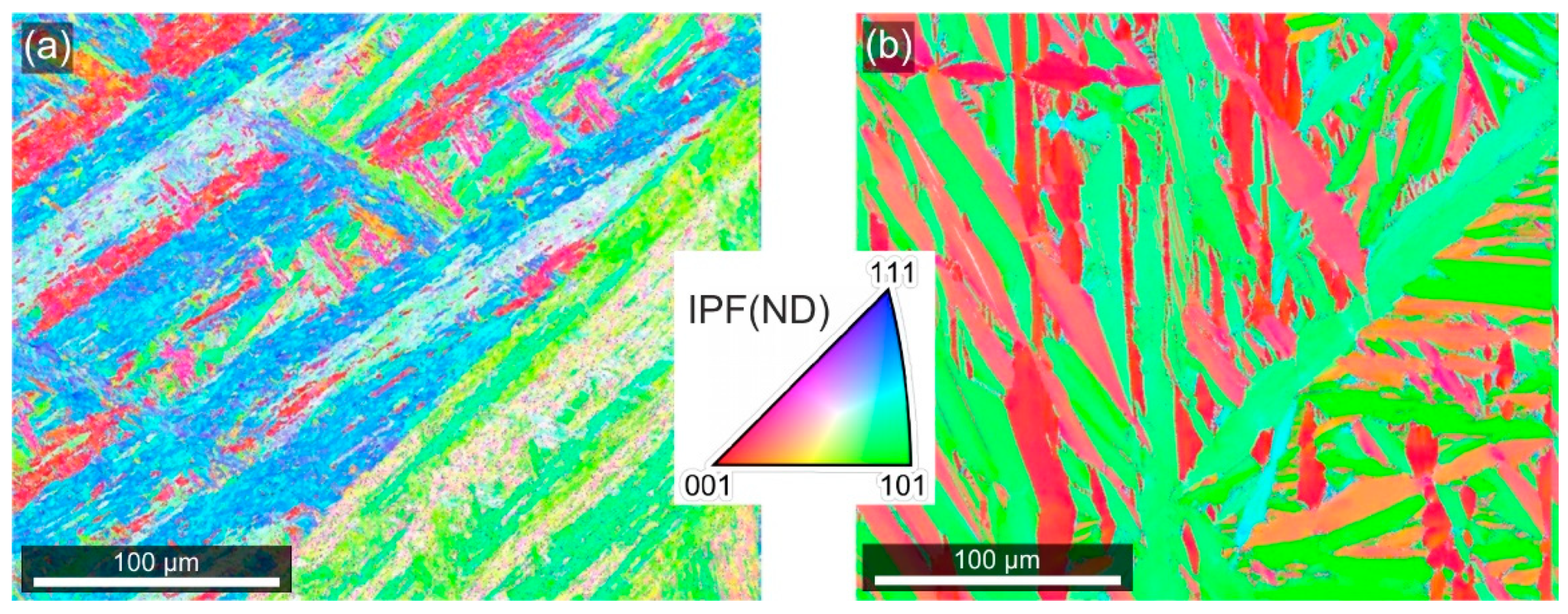
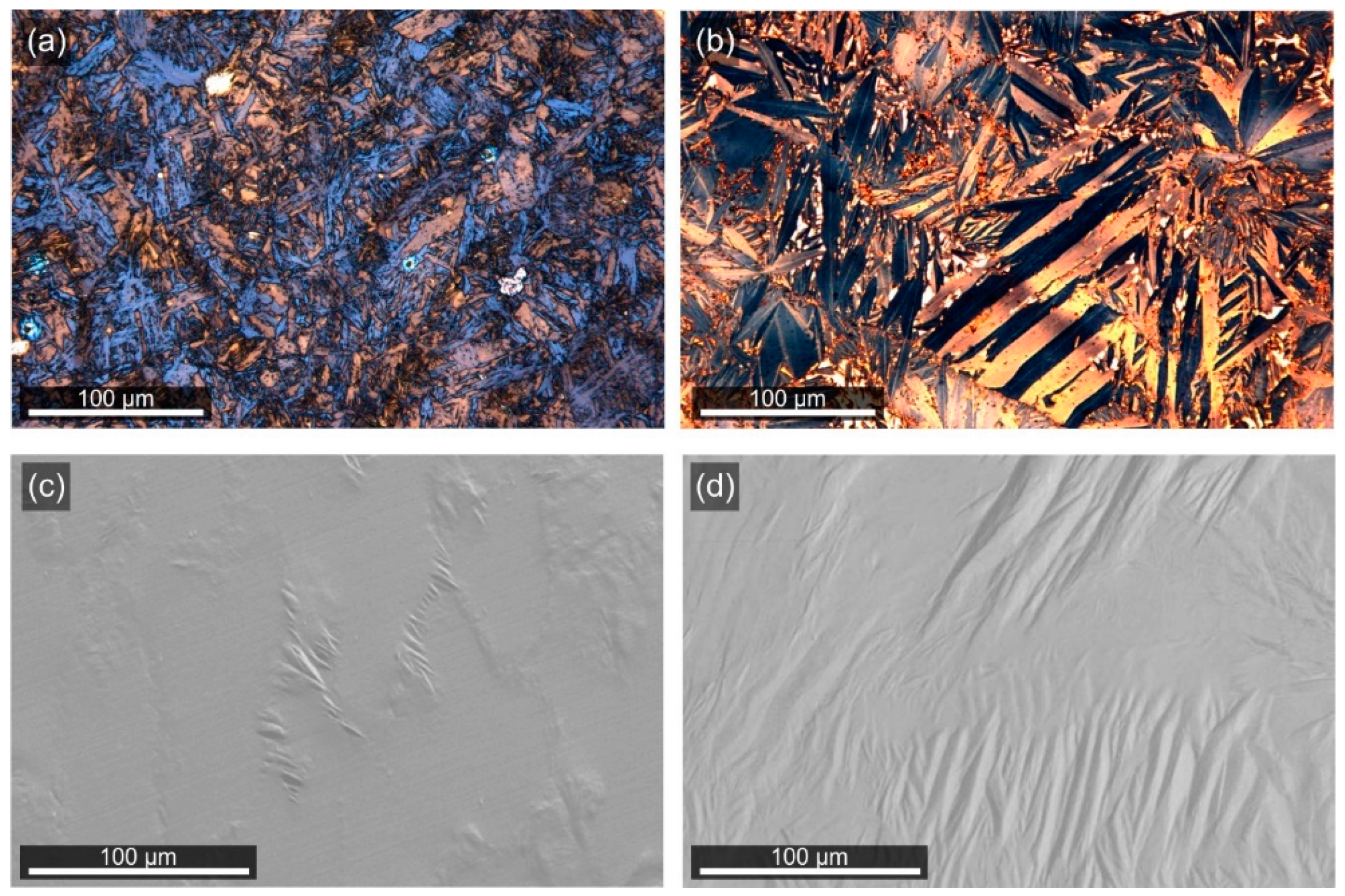
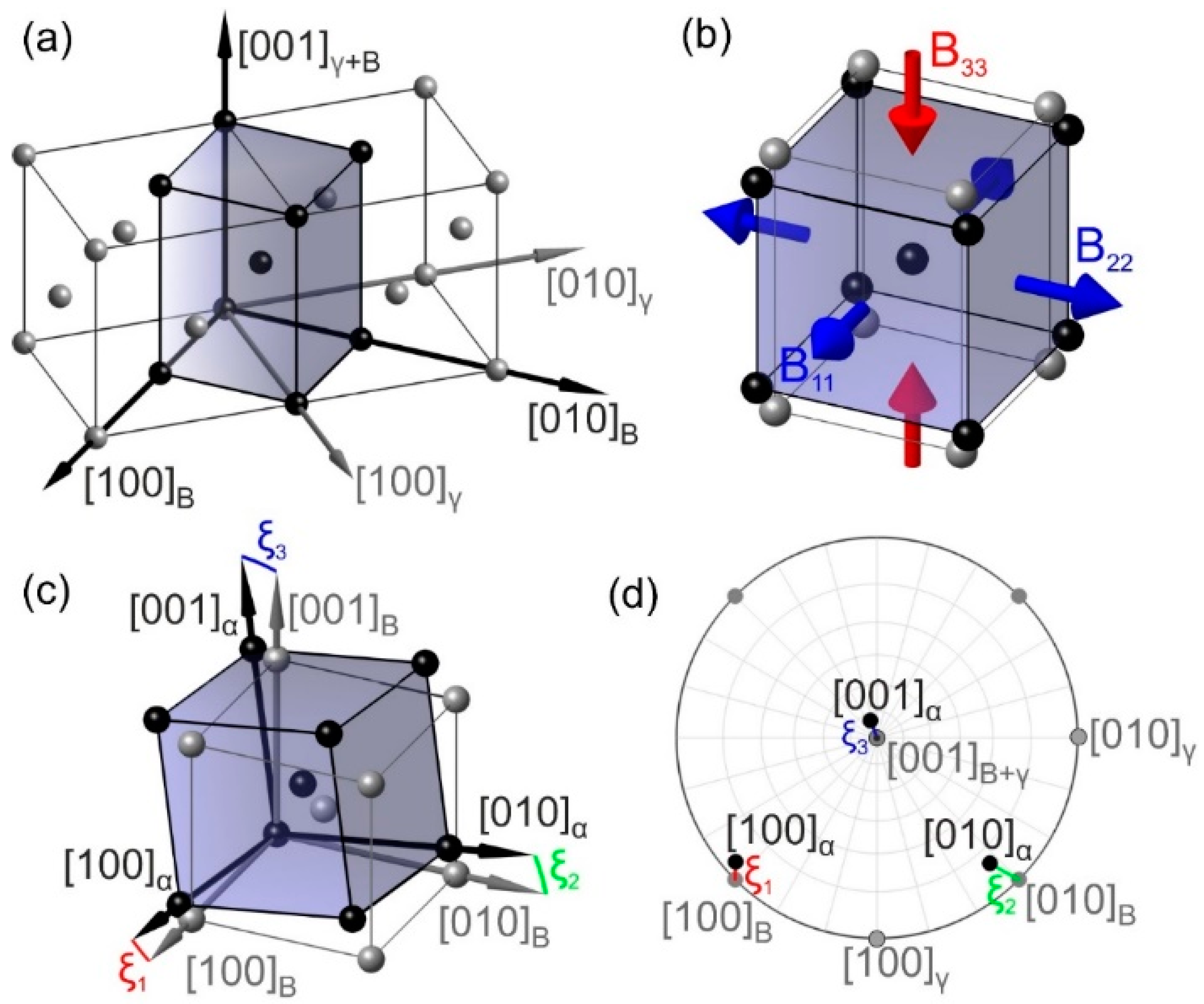
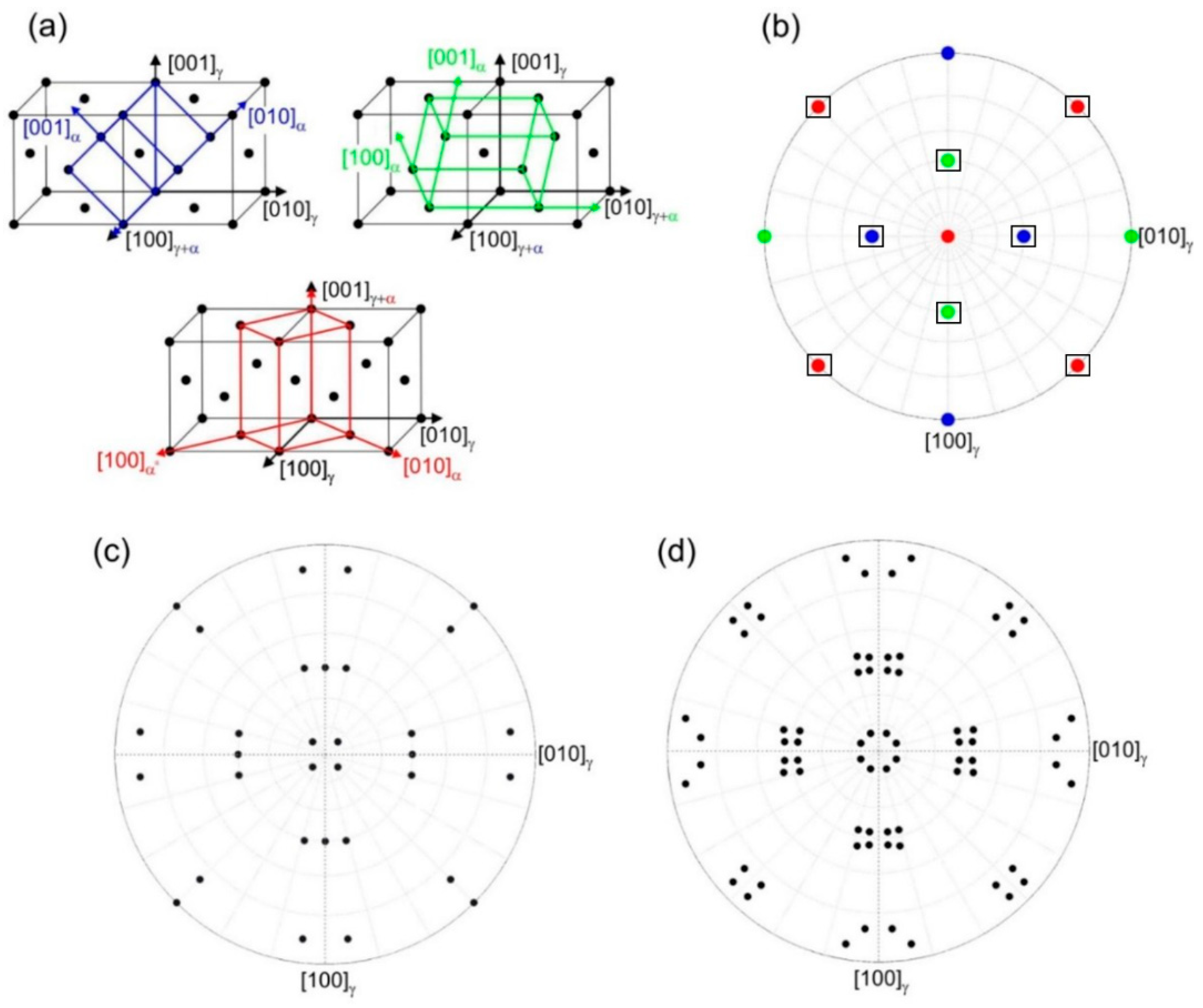
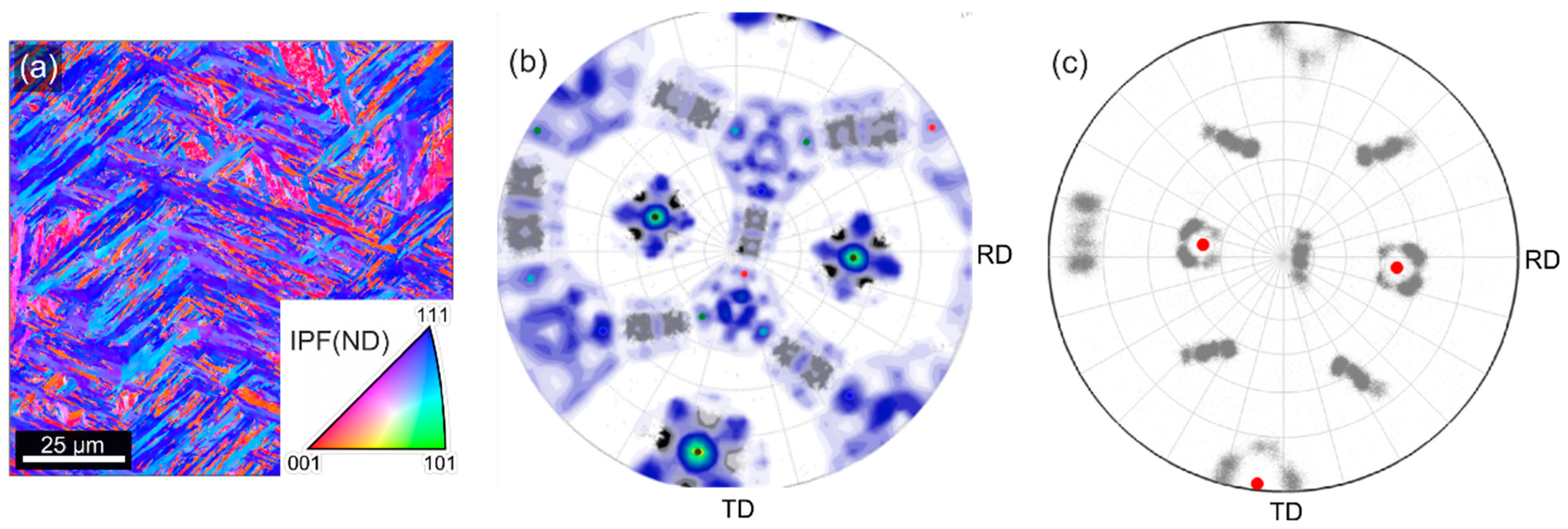
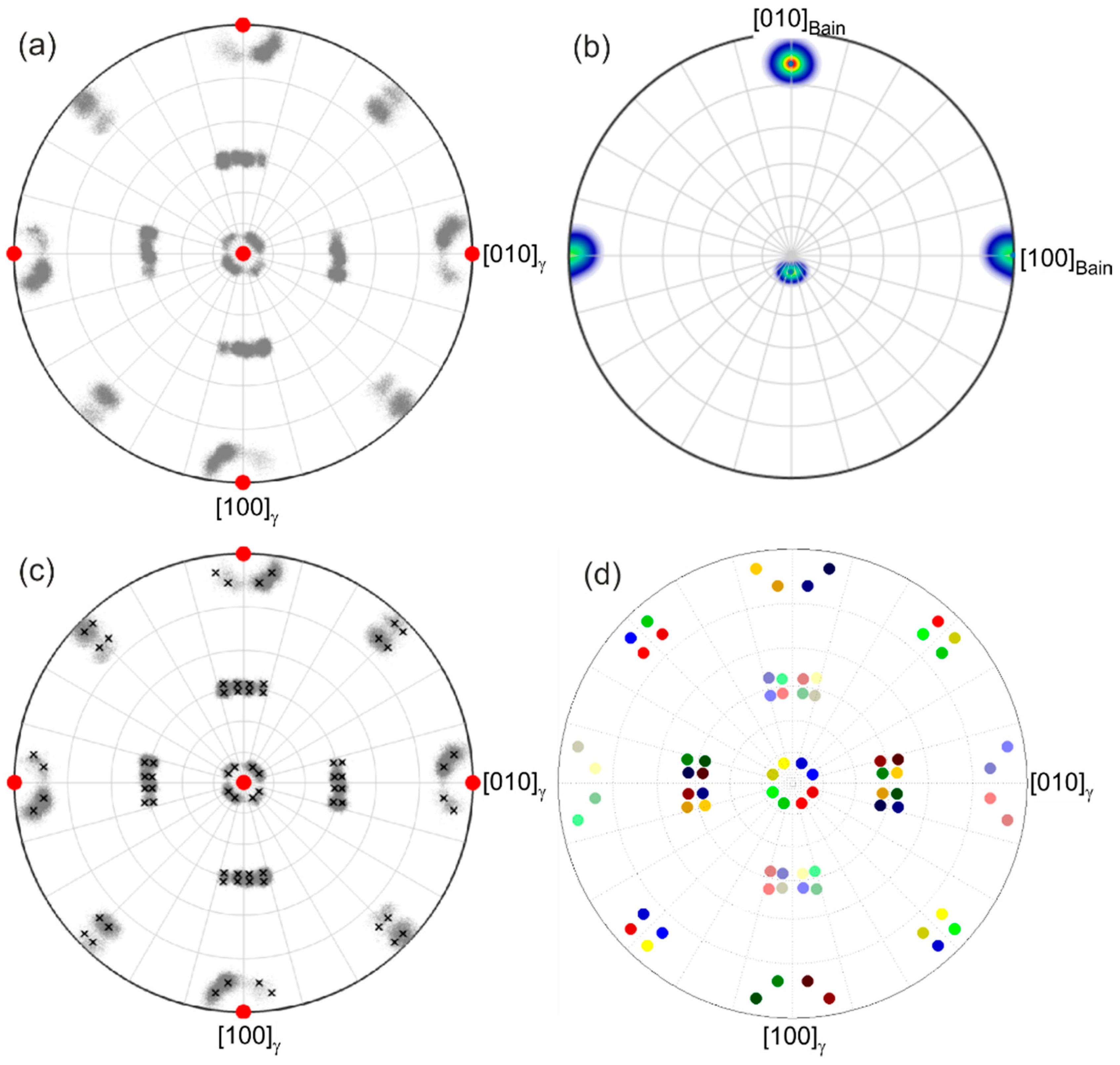
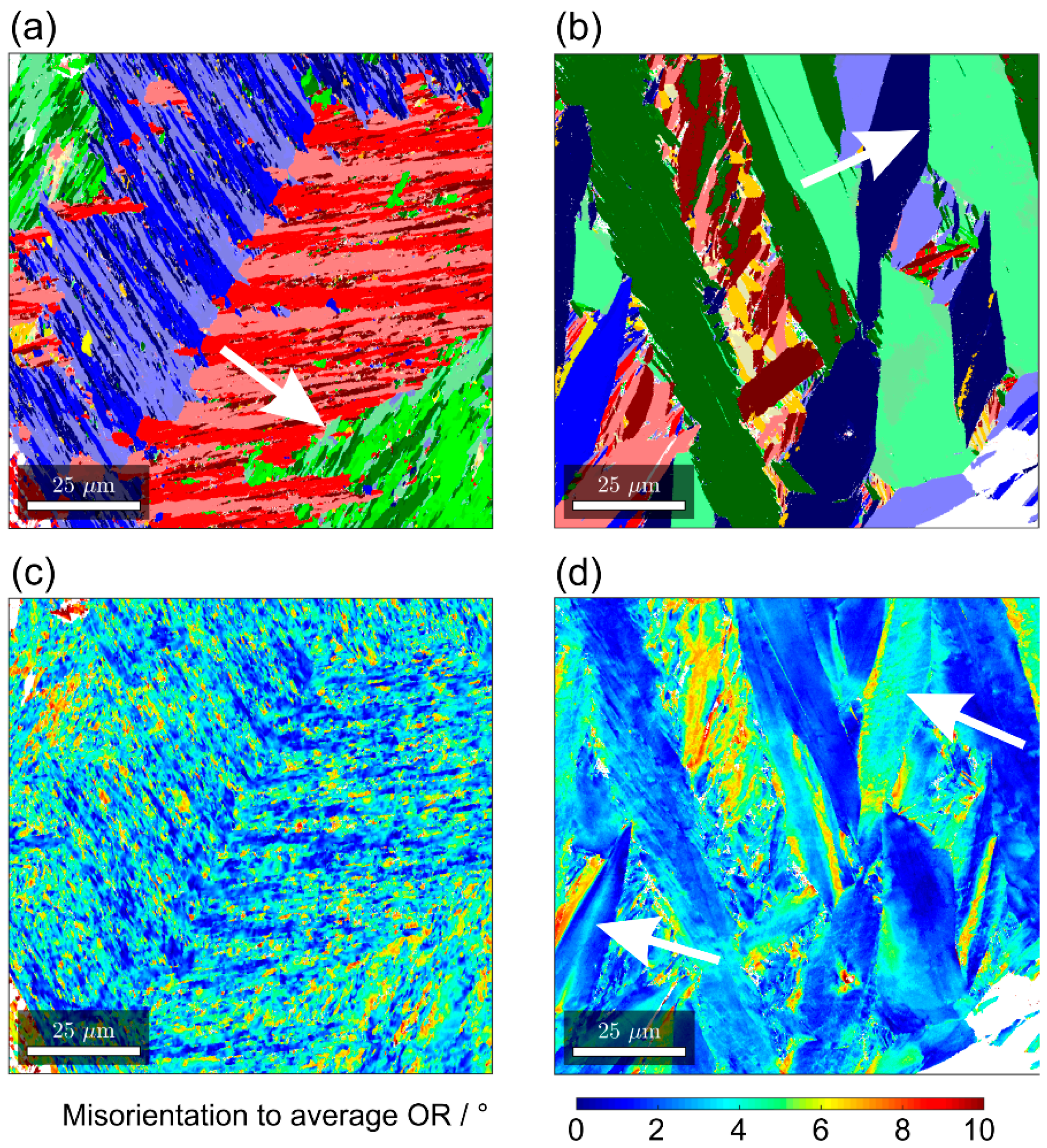
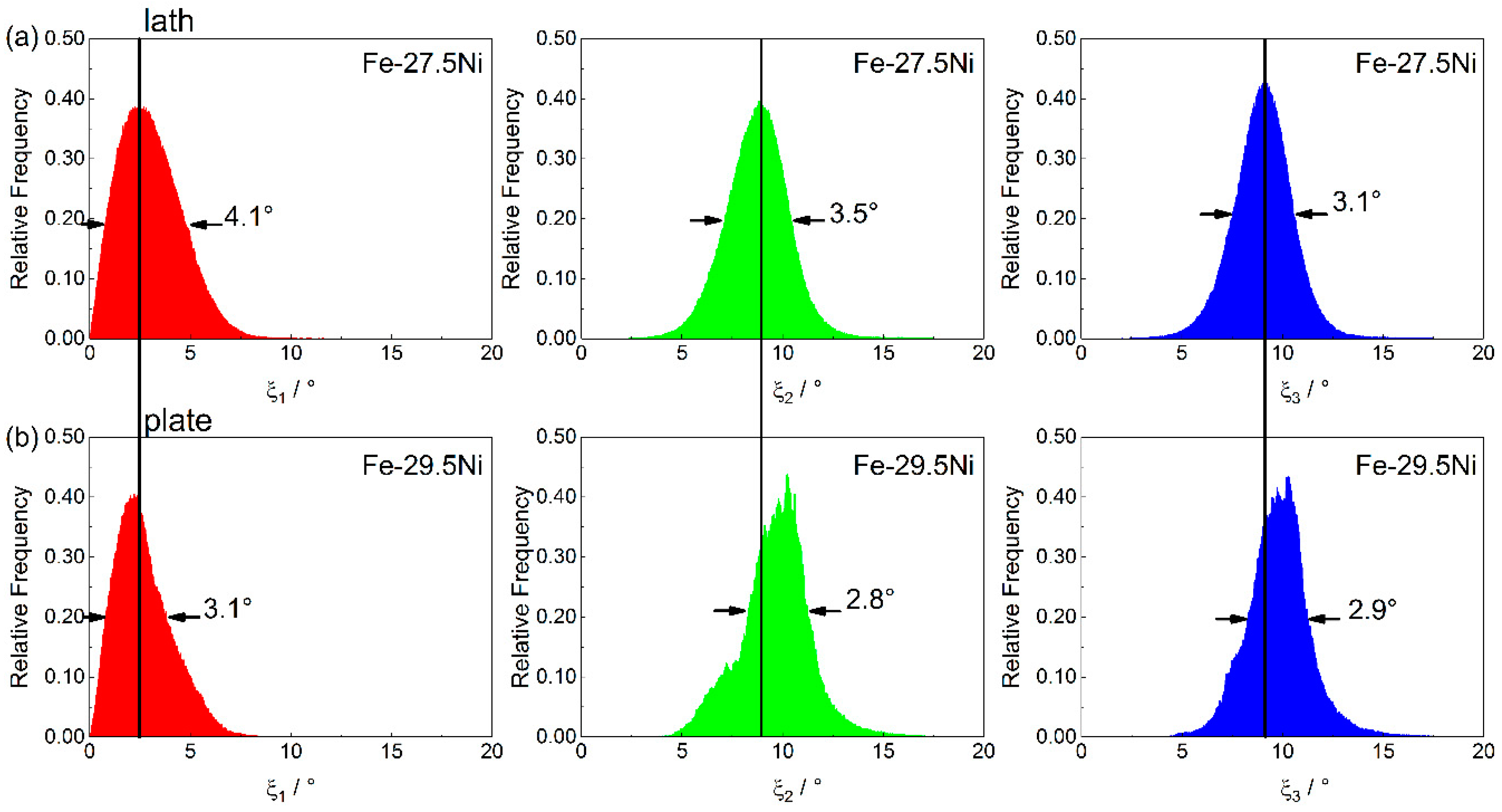

Publisher’s Note: MDPI stays neutral with regard to jurisdictional claims in published maps and institutional affiliations. |
© 2022 by the authors. Licensee MDPI, Basel, Switzerland. This article is an open access article distributed under the terms and conditions of the Creative Commons Attribution (CC BY) license (https://creativecommons.org/licenses/by/4.0/).
Share and Cite
Thome, P.; Schneider, M.; Yardley, V.A.; Payton, E.J.; Eggeler, G. Crystallographic Analysis of Plate and Lath Martensite in Fe-Ni Alloys. Crystals 2022, 12, 156. https://doi.org/10.3390/cryst12020156
Thome P, Schneider M, Yardley VA, Payton EJ, Eggeler G. Crystallographic Analysis of Plate and Lath Martensite in Fe-Ni Alloys. Crystals. 2022; 12(2):156. https://doi.org/10.3390/cryst12020156
Chicago/Turabian StyleThome, Pascal, Mike Schneider, Victoria A. Yardley, Eric J. Payton, and Gunther Eggeler. 2022. "Crystallographic Analysis of Plate and Lath Martensite in Fe-Ni Alloys" Crystals 12, no. 2: 156. https://doi.org/10.3390/cryst12020156
APA StyleThome, P., Schneider, M., Yardley, V. A., Payton, E. J., & Eggeler, G. (2022). Crystallographic Analysis of Plate and Lath Martensite in Fe-Ni Alloys. Crystals, 12(2), 156. https://doi.org/10.3390/cryst12020156





